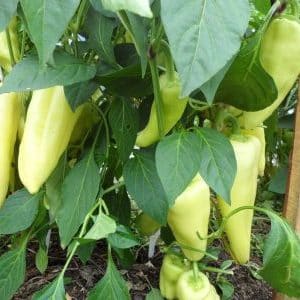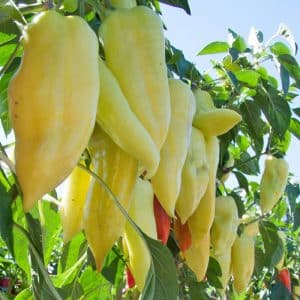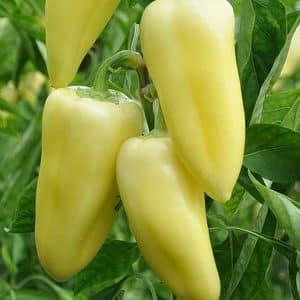How to grow sweet pepper “Snowfall” on your own plot: step-by-step instructions and expert reviews
Pepper Snowfall F1 grows successfully in regions with temperate and warm climates and has many positive qualities. In the Russian Federation, this hybrid is mainly grown in greenhouse conditions, but this does not make its taste any worse.
To get healthy, strong seedlings and achieve high yields, vegetable growers follow a number of rules - we will talk about them in this article.
What kind of pepper is this
Pepper Snowfall is reliable when grown, has excellent germination and productivity. In the southern regions it is successfully grown in open ground, in the middle zone and in the north - more often in greenhouses. The hybrid has strong immunity to diseases and pests.
Hybrid f1
Pepper Snowfall belongs to the first generation of hybrids, as evidenced by the f1 index in the name. Breeders create hybrids by crossing parent varieties. They do this to obtain a stronger and more productive plant.

Characteristics and description of pepper
Snowfall—early ripening pepper. It begins to bear fruit after 110-120 days. Inflorescences are formed after 8-12 leaves.
Mature bushes are powerful and tall (up to 80 cm) with a large number of leaves and fruits. To get an excellent harvest, 3-4 bushes are planted in a small area. The fruits are juicy and sweet, and are versatile in cooking. They make the same delicious dishes, salads and canned food.
Distinctive features
Many gardeners who grow bell peppers prefer hybrid Snowfall.It has its own special taste, and in terms of yield it has almost no competitors. The seeds have high germination rate.
Fruit characteristics, yield
Snowfall f1 produces elongated, cone-shaped fruits, up to 15 cm in length. One pepper weighs about 100 g. During the period of technical maturity, the shell of the vegetable is thin, smooth, milky-cream in color; with further ripening, the skin acquires a reddish color. The fruits are not too fleshy, but the pulp is juicy and sweet. Wall thickness is average (6-8 mm).
Subject to agrotechnical rules, vegetable growers harvest up to 50-60 vegetables (about 5 kg of harvest) from one bush.
Important! Snowfall pepper is a hybrid, not a variety, so it makes no sense to collect seeds from your own harvest: subsequent generations lose their characteristics.
Preparation for cultivation
In order for more air and moisture to reach the roots, the soil for seedlings must be loose and nutritious. The soil can be purchased at a gardening store or prepared independently. To do this, mix garden soil, turf, sand and humus in equal parts. Add a glass of wood ash to 10 kg of the finished mixture.
For your information. Peat and sand can be replaced with sawdust by treating them with boiling water beforehand.
To make the soil fertile, add 25 g of phosphorus and potassium fertilizer and 10 g of urea per bucket of water.
Before planting, seed material is disinfected. To do this, the seeds are placed for 20 minutes in a 1% solution of potassium permanganate, then washed under running water and dried.
Growing seedlings
Sowing seeds for seedlings is carried out 50-60 days before the intended planting in a permanent place. In order not to injure young plants during transplantation, the seeds are planted in peat containers, two at a time.
The container with seedlings is covered with transparent film or glass and placed in a warm place. Water, or rather moisten, using a sprayer so as not to wash away the top layer of soil. Moisturizing is carried out regularly, but in moderation. When shoots appear, the film is removed.
On a note. It is important that the seedlings are located in an area of high humidity.
When the pepper has a pair of true leaves, the weaker plant is removed and the stronger plant is planted in a larger container. Seedlings are not removed from peat products; such a container in the soil itself becomes limp and dissolves.
 To begin with, the container with plants is placed in a cool, bright place. After two weeks, place in warmer conditions or increase the temperature, if possible.
To begin with, the container with plants is placed in a cool, bright place. After two weeks, place in warmer conditions or increase the temperature, if possible.
Residents of the northern regions evenly install phytolamps over the seedlings for additional lighting.
Before transplanting plants to a permanent place, peppers are fed 2-3 times. For this, special fertilizers are used, for example, Agricola, Biohumus or Potassium Humate.
Planting pepper
Before planting, hardening is carried out again. To do this, the bushes are taken out onto the street or balcony for 1-1.5 hours 10 days before planting. The time the plants spend in the fresh air is gradually increased.
Peppers are not grown in areas where tomatoes or potatoes used to grow. Good predecessors - cucumbers, cabbage, onions or melons.
Snowfall pepper does not tolerate wind well, so in the northern regions it is grown under film cover. For the south of the country, choose a closed, sunny area.
Further care
In the first days after planting, the plants are watered frequently as the soil dries, then once every 10 days. On hot days, the crop is moistened in the evening or morning hours, when the sun is not scorching.Water the pepper carefully, avoiding splashes on the leaves and stem, to avoid sunburn.
 The appearance of a new leaf indicates that the plant has taken root in a new place, and it’s time to apply fertilizer. Fertilizing is combined with watering. For this, potassium and phosphorus complexes with the addition of urea are used. During the entire growing season, peppers are fed 2-3 times. All fertilizers are applied in the evening, onto moist soil.
The appearance of a new leaf indicates that the plant has taken root in a new place, and it’s time to apply fertilizer. Fertilizing is combined with watering. For this, potassium and phosphorus complexes with the addition of urea are used. During the entire growing season, peppers are fed 2-3 times. All fertilizers are applied in the evening, onto moist soil.
The soil around the plants is carefully loosened (no deeper than 6 cm). The procedure is carried out at least once every 2 weeks, trying not to damage the roots. To ensure air access to the roots, row spacing is often loosened a day after watering.
Bushes are formed by removing excess foliage and stepsons that grow until the stem branches, leaving 4-5 upper stepsons. They also get rid of branches and ovaries inside the bush so that there is no shading - in the shade the fruits will grow deformed. In dry and hot weather, pinching is not carried out, since foliage and branches protect the soil from drying out.
Features of growing peppers and possible difficulties
Supports are installed for peppers, since heavy rain and wind can knock down or break the plants. The culture responds well to constant soil moisture and the absence of drafts.
To retain moisture in the ground longer, mulch the soil with straw, sawdust, weeds or pine needles, laying a layer of 7-10 cm.
Important! The plant should be in the sun all day, but in hot weather the bushes are covered with cloth or burdock, protecting the crop from burns and wilting.
Typical diseases and pests
To prevent diseases, peppers are treated twice a season with copper-containing preparations (Bordeaux mixture, copper sulfate, HOM and Oksikhom).Special products are used against aphids and mites (“Healthy Garden”, “Fitoverm”, “Korado” or “Aktara”).
Pepper bushes are regularly inspected in order to detect the first signs of disease in time and begin the fight:
- the formation of purple spots on leaves and fruits indicates a lack of phosphorus;
- root rot appears due to waterlogging of the soil;
- white, scorched spots on vegetables are a consequence of sunburn;
- the formation of rot on the fruit indicates that the pepper does not have enough calcium;
- a brown border on curled leaves is due to a lack of potassium.
Some vegetable growers plant peppers next to bush beans. This repels pests and improves crop growth. Basil, onions, garlic, marigolds and wormwood are planted between the rows. The pungent smell of these plants drives away insects.
Important! During fruiting, no chemicals are used.
Advantages and disadvantages
Vegetable growers like Snowfall pepper f1 for the following advantages:
- excellent fruit taste and versatility in use;
- high productivity;
- presentation of pepper;
- transportability of vegetables;
- unpretentiousness of the plant in care;
- strong immunity to diseases and pests.
If the pepper grows in an area with a mild climate, then control of its growth is not necessary. It is enough to tie the plants to the stakes. Pepper Snowfall produces a large harvest, so the bushes need support. Otherwise, in rainy and windy weather, the plants will break due to the weight of the fruit.
Reviews
Summer residents speak positively about the Snowfall f1 pepper, since the hybrid produces a large harvest and does not require special care.
Tatyana, Voronezh: “A neighbor once advised me to plant Snowfall pepper - the description and reviews of this hybrid suited me quite well. The seeds have all sprouted.The seedlings were strong. I transplanted the plants into the greenhouse around the end of May. I collected a lot of harvest, I didn’t even know what to do with it. I treated my relatives with vegetables. The fruits are beautiful and neat, as in the photo of the package with seeds. The pepper taste is excellent. I liked the hybrid and will continue to grow it!”
Vasily, Volgograd: “I bought Snowfall pepper seeds at a gardening store. The price is incredible. The crop was grown in seedlings and left for a little while. An ovary has formed on some bushes. I planted the pepper in its permanent location on May 25th. The plants have taken root well. The crop began to bear fruit around the beginning of August. The vegetables taste sweet and juicy. What surprised me most was the high yield. The hybrid practically didn’t get sick.”
Conclusion
Gardeners prefer this pepper not only for its beautiful appearance, but also for its excellent taste, meatiness and high yield. It contains many vitamins, especially C, and microelements that are necessary for humans. Fruit save beneficial properties even when frozen. If desired, even a beginner can cope with growing Snowfall peppers if they put in a little effort.
You will learn more about the Snowfall pepper from the video: